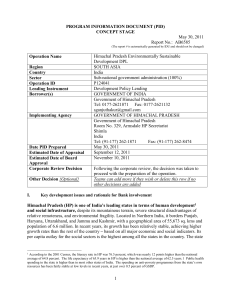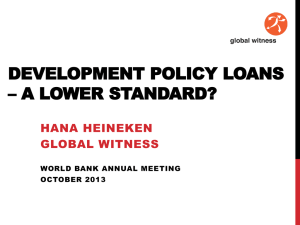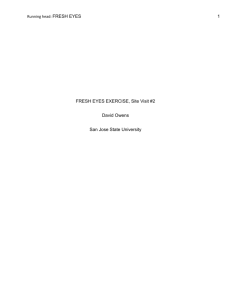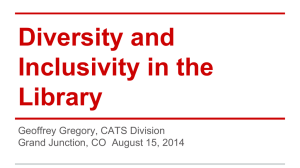Program Information Document - Documents & Reports
advertisement
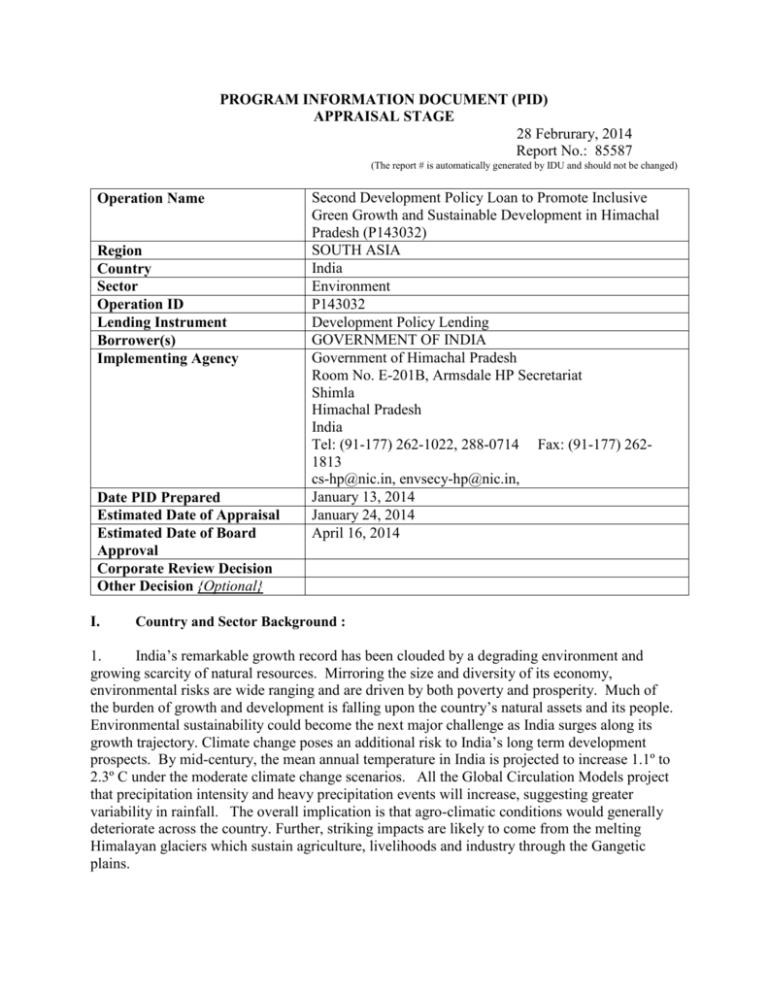
PROGRAM INFORMATION DOCUMENT (PID)
APPRAISAL STAGE
28 Februrary, 2014
Report No.: 85587
(The report # is automatically generated by IDU and should not be changed)
Operation Name
Region
Country
Sector
Operation ID
Lending Instrument
Borrower(s)
Implementing Agency
Date PID Prepared
Estimated Date of Appraisal
Estimated Date of Board
Approval
Corporate Review Decision
Other Decision {Optional}
I.
Second Development Policy Loan to Promote Inclusive
Green Growth and Sustainable Development in Himachal
Pradesh (P143032)
SOUTH ASIA
India
Environment
P143032
Development Policy Lending
GOVERNMENT OF INDIA
Government of Himachal Pradesh
Room No. E-201B, Armsdale HP Secretariat
Shimla
Himachal Pradesh
India
Tel: (91-177) 262-1022, 288-0714 Fax: (91-177) 2621813
cs-hp@nic.in, envsecy-hp@nic.in,
January 13, 2014
January 24, 2014
April 16, 2014
Country and Sector Background :
1.
India’s remarkable growth record has been clouded by a degrading environment and
growing scarcity of natural resources. Mirroring the size and diversity of its economy,
environmental risks are wide ranging and are driven by both poverty and prosperity. Much of
the burden of growth and development is falling upon the country’s natural assets and its people.
Environmental sustainability could become the next major challenge as India surges along its
growth trajectory. Climate change poses an additional risk to India’s long term development
prospects. By mid-century, the mean annual temperature in India is projected to increase 1.1º to
2.3º C under the moderate climate change scenarios. All the Global Circulation Models project
that precipitation intensity and heavy precipitation events will increase, suggesting greater
variability in rainfall. The overall implication is that agro-climatic conditions would generally
deteriorate across the country. Further, striking impacts are likely to come from the melting
Himalayan glaciers which sustain agriculture, livelihoods and industry through the Gangetic
plains.
2.
Himachal Pradesh (HP) is richly endowed with natural resources that provide
economically valuable environmental services for much of the country. The state is home to
three major river basins, and serves as a watershed that is critical to the livelihoods of more than
200 million people in Haryana, Punjab, Uttar Pradesh, and Rajasthan. It has one of the main
sources of clean energy – hydropower - for the country that can help address both the energy
and peak shortages of the Northern Region. The watersheds of HP also act as an important
carbon sink for greenhouse gases. Altitudinal variation has generated habitats that host immense
numbers of species, which demonstrate a high degree of endemism – that is species only found
in these ecosystems. Parts of the region are classified as global biodiversity hotspots –signaling
scientific concern for the unrelenting pressures on the Himalayan ecosystem. There is also
considerable potential for attracting higher value added tourists in the state, with a unique
combination of attractions that includes natural assets, historic architecture (Shimla) and
cultural and religious attractions.
3.
Rapid industrialization in HP has generated a number of industrial clusters where
environmental quality (air and water pollution) is rapidly deteriorating causing hazardous
conditions for neighboring communities and ecosystems. While the State Pollution Control
Board (SPCB) is mandated with regulation of environmental laws, the Industries Department
which promotes industrial development is now trying to identify interventions for areas which
have become ―pollution hot spots especially given the ecological fragility of the state.
4.
Being one of HP’s main drivers of the state’s economic growth, Tourism is a very
important activity that contributes to both the gross domestic product and the employment in the
state. Recent estimates using TSA methodologies indicate that the contribution of inbound
tourists (foreign and domestic) to the state GDP may be as high as 26 percent; with the specific
contribution of foreign tourists in the state estimated to be significantly the largest and over 20
percent. The tourism sector’s potential growth is also intricately linked with environmental
quality. GoHP’s target is to increase the contribution of tourism to GSDP to 15 percent by 2020.
GoHP wants to ensure that tourism development does not happen at the cost of the fragile
ecosystem of the state
5.
GoI sought a program of series of two DPLs of US$100 million each from IBRD
resources to finance the first in a series of two DPLs, and an additional US$ 100 million of CTF
resources for the second DPL in the series. This is consistent with the practice to leverage CTF
resources with funds from multilateral agencies. This two-part programmatic DPL series is
designed to support a subset of GOHP’s plans by enabling policies, institutional actions and
piloting of innovative practices that are deemed catalyticfor long-term change in sectors that are
the key drivers of economic growth. These actions include:
Adoption of environmentally sustainable and socially responsible hydropower
development in the ongoing hydro development program
Integration of climate change adaptation and mitigation actions in policies and
programs
Empowering local communities to promote watershed management
Promotion of an environmentally sustainable industrial development;
II.
Implement an environmentally sustainable tourism program;
Instituting mechanisms for integration of spatial GIS based information in
informed decision making.
Operation Objectives :
6.
The objective of this Programmatic DPL series is to support HP in making a
paradigm shift towards an environmentally sustainable model of economic growth by promoting
improved management of its natural resources and inclusive green growth. The focus is on
providing the key foundations that define the short term measures necessary to achieve these
longer term objectives. This is to be achieved by promoting the sustainable use of the State’s
natural resources – in particular it’s abundant water supplies, forests and biodiversity.
7.
The overall operation consists of two DPLs of US$ 100 million each: the first was
approved by IBRD in September 2012; the second is to be financed by the Clean Technology
Fund (CTF). This program seeks to pilot the DPL as a lending instrument in the CTF, and to
inform the debate on how such an instrument can be effectively applied in climate finance more
broadly.
The IBRD and CTF funded operations support specific policy and institutional measures
within GoHP’s overall environmental sustainability reform agenda that have been mutually
agreed as critical to achieving this transformation. The following sections describe the individual
actions within the broad framework that forms the legal basis for the disbursement of the
proposed Second HP IGG DPL. The Bank and the Government have identified the prior actions
through a process of mutual consultations.
8.
The prior actions for the second operation of HPIGG DPL are presented in the Table -1 below;
Table 1:
Prior Actions for IGG DPL 2
Prior Actions/Milestones
Goal: A-- GoHP has designed, adopted and implemented a webIncreased adoption of
based real-time monitoring system for project
environmental and
milestones, including those relating to environment and
social parameters in
social parameters and environmental flows.
hydropower
GoHP has (i) carried out an interim review of the ondevelopment
going cumulative environmental impact assessment
study of the Satluj river basin; and (ii) developed a
concurrent action plan.
GoHP has adopted and implemented a benefit sharing
scheme to complement the Local Area Development
Fund, by initiating the payment of Cash Transfers to
Eligible Beneficiaries
Goal :B---Increased
integration of climate
GoHP has prepared and publicly disclosed Himachal
Pradesh’s comprehensive Action Plan on Climate
change adaptation
and mitigating
measures in state
development plans
Goal: C – Increased
local communities
participation in
development of
watershed
management.
Goal: D – Increased
adoption of Sound
Environmental
Management
Practices in
industrial
development.
Goal :E – Increased
adoption of sound
environmental
management
practices practices
in tourism
development
Goal: F- Improved
Integration of GIS
mapping and
Decision making in
the state.
Change.
GoHP has: (i) carried out a state-wide ecosystems
evaluation analysis, and (ii) issued notification of a state
policy on payments for ecosystem services
GoHP has: (i) begun the implementation of the IWMP
Guidelines, by preparing through a multi-disciplinary
team, and adopting, integrated Micro-Watershed
Development Plans (one per Block); which plans are
publicly monitored and disclosed in AGiSAC’s website;
and (ii) prepared and commenced the implementation of
a capacity building plan for stakeholders departments.
GoHP has amended the HP Water Policy-2005 through
the notification of the new HP Water Policy-2013 for the
sustainable management of HP water resources
GoHP has designed and issued notification on
economic instruments for incentivizing the adoption of
cleaner technologies, and has decided to disincentivize the
industries identified in the Negative List (which largely
consists of polluting industries).
GoHP has amended the Tourism Policy-2005
through the adoption of the Sustainable Tourism
Development Policy-2013 in order to ensure the
environmental sustainability of the activities in the sector,
including the use of economic instruments to internalize
environmental externalities of tourism.
GoHP has commenced the implementation of
sustainable tourism practices in Himachal Pradesh.
GoHP has issued an Order operationalizing
AGiSAC’s protocols for monitoring and evaluation of
activities in the infrastructure and natural resources
management sectors, including the integration of geoinformatics technology
III.
Rationale for Bank Involvement
9.
Recognizing the unique challenges of developing in a sustainable manner in the
fragile and rugged Himalayan region, HP is seeking policy support for a pioneering effort to
promote growth through environmental stewardship. The Bank can bring a wide spectrum of
global best practice and experience from its environmental support in other countries. Examples
include: state level climate change planning and activities (Mexico); ecotourism and
sustainability (Mexico, Sri Lanka, Maldives); building institutional capacity (Peru, Ghana,
Brazil); fostering inter and intra institutional coordination (Morocco); strengthening enforcement
and compliance (Mexico, Morocco); enhancing reform durability (Ghana); facilitating civil
society outreach and partnership (Brazil, Colombia, Mexico); supporting sustainable natural
resources (Cameroon, Laos, Columbia, Mexico); managing environmental risks (Peru, Morocco,
Columbia); promoting regional and global public goods (Turkey, Mexico); building adaptation
capacity (Indonesia, Vietnam) and promoting resilience to climate-change induced hazards
through activities in every continent.
10.
The loan aligns well with the Country Partnership Strategy (CPS) for India (Report No.
76176-IN) that will support the Government’s development goal of growth that is faster, more
socially and regionally inclusive, and more sustainable as detailed in the 12th Five-Year Plan
(FY2013–17). The CPS also clearly identifies that GoI now seeks World Bank support only for
projects that have a systemic or transformational impact, those that help innovate and pilot new
approaches, and finally those that introduce innovative financing instruments and leverage
resources. This is what the HP IGG DPL program intends to achieve. It some ways the HP IGG
DPL program breaks new ground, which could have significant demonstration effects in
promoting the inclusive green growth agenda in other resource rich states in India and as well in
the region.
IV.
Tentative financing (Current DPL operation)
Source:
Borrower
International Bank for Reconstruction and Development
Clean Technology Fund
Borrower/Recipient
IBRD
Others (specify)
($m.)
-0-0100
-0-
Total
100
V.
Institutional and Implementation Arrangements
11. A high level committee headed by the Chief Secretary (highest ranking official of State
administration) to monitor and implement agreed DPL policy actions, with DEST (expand
acronym) responsible for the multi-sector coordination has been established in the state.
12. The GoHP has also established the Aryabhatta Geoinformatics and Space Application
Center (AGiSAC) to assist with generating information for monitoring using geo-spatial
information. AGiSAC will cover all major sectors of remote sensing applications in
decentralized planning, and is expected to play a significant role in monitoring of results across
the DPL operation. The GoHP has also operationalized and integrated geo-informatics
technology for infrastructure and natural resources, through the issuance of protocols for
monitoring and evaluation by AGiSAC.
13. Having established AGiSAC to promote integrated GIS mapping and decision-making,
GoHP aims to take the next steps to make operational monitoring and evaluation of
infrastructure and natural resources management sector through integrating geo-informatics
technology.
VI.
Risks and Risk Mitigation
The Program Operation is anticipated to deliver overall green growth benefits but there
are certain risks that emerge from the operation. The main risks under the different
categories and the corresponding responses to mitigate risks are as follows:
Political and governance (moderate risk): There is strong multi-party support among the
major political parties and a growing consensus that a paradigm shift towards a
sustainable economic growth model would be universally beneficial for the State.
Political and governance risk is therefore low and requires no mitigation.
Institutional (substantial risk): Traditionally, the State has had limited focus on
environmental sustainability issues in its sector policies, and monitoring and evaluation
on these issues is also weak. This risk has been largely mitigated through a high level
committee headed by the Chief Secretary (Highest ranking official of State
administration) to monitor and implement agreed DPL policy actions, with DEST
responsible for the multi-sector coordination. This is also the first DPL operation to be
funded from CTF and will therefore be subject to certain level of scrutiny. It is therefore
anticipated that emission reductions to be achieved in the key sectors through these
transformative policy reforms will be monitored and reported at requisite intervals. A
Technical Assistance is being discussed and agreed with Trust Fund (DFID etc.) funding
to support monitoring of results beyond DPL time lines.
Operational design, implementation and sustainability (moderate risk): The program’s
objectives are ambitious and require continual effort over a significant period of time
before the inclusive growth and sustainable development paradigm gets established. In
order to help alleviate these constraints, the GoHP has built the capacities of the
Department of Energy and Environment for effective coordination and implementation
by increasing the staffing levels and bringing in technical experts in the areas of
environmental management.
Reputational (substantial risk): The DPL program aims to support GoHP in the improved
management of its natural resources across key sectors that are the growth engines of its
economy, viz. i.e. energy, industry and tourism. The thrust of the DPL program is on
facilitating the adoption of policy and institutional reform actions that will make the
state’s development plans more environmentally sustainable and socially responsible.
Possible risk to the Bank’s reputation can accrue only in the event that these actions are
not sustained. This risk is potentially mitigated by the fact that there has been consistent
ownership in the state (including across the political spectrum as evidenced by the fact
that two different political coalitions have supported the two phases of the DPL) for
improved stewardship of its natural resources. Consultations with other stakeholders
conducted by the government have also revealed a demand for these actions aimed at
promoting the long-term sustainability of Himachal Pradesh’s growth agenda. However,
given the inherent complexities, especially vis a vis the fragile natural environment, the
risk rating is retained as Substantial.
VII.
Poverty and Social Impacts and Environment Aspects
14.
Poverty and Social Impacts
a) At the macro level, the proposed reform program will contribute to the ongoing
transformation of the state’s economy toward secondary, tertiary and
infrastructure sectors while providing a new impetus to growth, which have the
potential to alter the state’s development trajectory in a context of high environmental
consciousness and cohesive social organization. Two specific areas of interest at the
micro level are: (i) the first-of-kind benefit-sharing program for local communities in
hydropower projects, through mandatory provisions to a Local Area Development
Fund and distribution of cash benefits to project-affected families; and (ii) promotion
of community-based watershed management approach in agricultural and
horticultural sectors and establishment of agribusiness centers, which will target
poverty alleviation through improved rural incomes and better market access.
A Poverty and Social Impact Analysis (PSIA) has therefore been undertaken, in
keeping with the Program Document for DPL I, to keep track of the impacts of the
unfolding reform.
b) In the first stage of the PSIA, the state’s development outcomes over time were
documented using the National Sample Survey (NSS) and drawing upon other
surveys such as the National Family Health Survey (NFHS). This was complemented
with primary data from an ethnographic study, which captures qualitative accounts of
the hopes and fears of the local population. Together, these sources provided an
understanding of the state’s social and economic development trajectory and serve as
an early assessment of the pitfalls associated with the reforms. The analysis revealed
that poverty headcount declined for all groups in Himachal Pradesh since the mid2000s, including the period between 2009/10 and 2011/12 during which the reforms
included in the DPL program were being rolled out. Similarly, the overall
employment rate has been consistently high, especially in comparison to neighboring
states, though there are important differences across social groups (most notably
among scheduled castes, tribes and other backward castes). However, women’s
employment has been consistently high in Himachal and it increased considerably
since 2009, despite remaining below male employment especially in urban areas.
Employment in the construction sector also increased rapidly since the industrial
reforms in the mid-2000s, but it flattened since 2009. The first stage was completed
and analysis presented in November 2013.
c) Further, the second stage of the PSIA is designed to monitor the social and
welfare impacts of benefit-sharing and community-based watershed management at
the community-level in order to facilitate better targeting, provide feedback for
effective implementation, and to promote long-term sustainability of hydropower.
15.
Environment Aspects
The policy reforms supported by HP IGG DPL II were examined for their effect on
environment, forests and other natural resources as per OP 8.60. It is clear from the review that
the GoHP’s plan of inclusive green growth agenda confers overall global and local
environmental benefits and the sub set of reforms supported by this operation will only have
positive effects. The proposed HP IGG DPL supports the Government of India (GoI) and
GoHP in a paradigm shift towards an environmentally sustainable model of economic
growth by promoting improved management of its natural resources, sustainability and
inclusive green growth. The GoHP has expressed strong interest to adopt and continue reforms
in key areas, in building its knowledge base and institutional capacity and in promoting
sustainability in its growth agenda. This is supported by environmental assessment work
undertaken for various projects in HP as well as from the analytical documentation that
addresses environmental issues and have been summarized in the Program document of the
operation.
VIII. Contact point
World Bank
Contact: Pyush Dogra
Title: Senior Environmental Specialist
Tel: 5785+47733 / 91-11-4924-7733
Fax: +91-11-24619393
Email: pdogra@worldbank.org
Location: New Delhi, India (IBRD)
Borrower
Contact:
Chief Secretary
Government of Himachal Pradesh
Room No. E-201B, Armsdale HP Secretariat
Shimla
Himachal Pradesh
India
Tel: (91-177) 262-1022, 288-0714 Fax: (91-177) 262-1813
cs-hp@nic.in , envsecy-hp@nic.in
IX.
For more information contact:
The InfoShop
The World Bank
1818 H Street, NW
Washington, D.C. 20433
Telephone: (202) 458-4500
Fax: (202) 522-1500
Web: http://www.worldbank.org/infoshop
